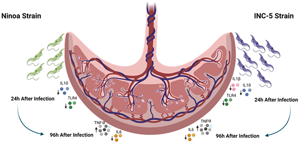Article contents
Congenital transmission of Mexican strains of Trypanosoma cruzi TcIa: interaction between parasite and human placental explants
Published online by Cambridge University Press: 24 November 2021
Abstract

Congenital transmission of Chagas disease plays an important role in endemic countries because it is not a diagnosis that is encountered frequently in prenatal care. Due to limited information regarding congenital transmission of Trypanosoma cruzi in Mexico, the present study aimed to investigate protozoan infectivity and modulation of immune responses in human placental explants infected with T. cruzi Ia Mexican strains. The Inc-5 strain showed increased infectivity and modulated IL-1β, IL-10 and TLR-4, decreasing their expression after 24 h of infection. Both strains (Inc-5 and Ninoa) stimulated the production of TNF-α and decreased IL-6 levels 96 h after infection. An important detachment of the syncytiotrophoblast caused by infection with T. cruzi was observed after 24 h of infection. In this study, ex vivo infection of human placental villi was performed to better understand interactions involving parasitic T. cruzi and human placental tissue. It was concluded that the strains of TcIa present parasitism in placental tissue, modulation of the innate immune system of the placenta, and cause intense detachment of the syncytiotrophoblast, a fact that may be more associated with abortion and premature birth events than the congenital transmission itself, justifying the low rate of this transmission mechanism by this genotype.
- Type
- Research Article
- Information
- Copyright
- Copyright © The Author(s), 2021. Published by Cambridge University Press
Footnotes
These authors contributed equally.
These senior authors contributed equally to this article.
References
- 2
- Cited by





